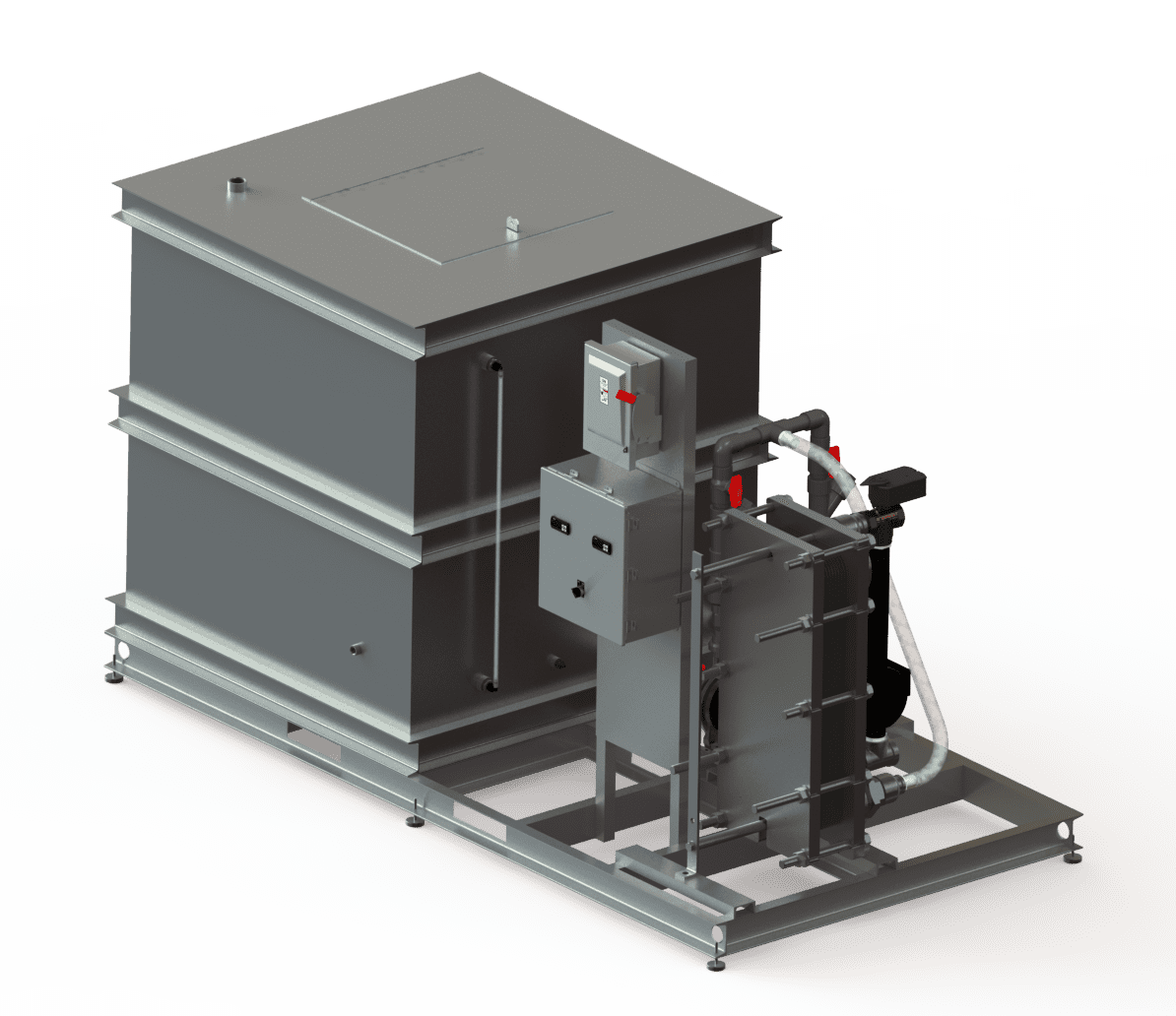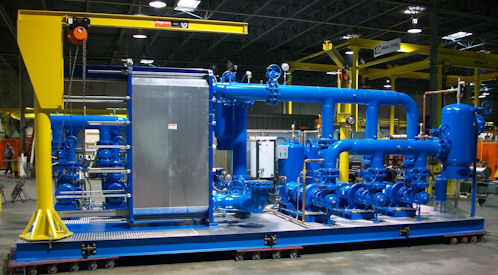How DVS Heat Transfer Systems Support Lifecycle Sustainability from Design to Disposal
Innovations in Heat Transfer Equipments: What You Required to Know for Optimal Performance
Innovations in Heat transfer systems are changing performance throughout different industries. Advanced products like graphene and nanofluids promise considerable renovations in thermal conductivity. The integration of IoT and equipment understanding offers possibilities for real-time tracking and boosted power efficiency. Nonetheless, the landscape of thermal monitoring is rapidly progressing (DVS Heat Transfer Systems). Comprehending these developments is essential for accomplishing perfect system performance and sustainability in the future. What particular innovations are shaping this improvement?
Emerging Products for Enhanced Heat Transfer

Advanced Heat Exchanger Layouts
While standard Heat exchangers have actually offered their function in different applications, advanced layouts are now emerging to fulfill the increasing needs for performance and performance. These cutting-edge designs, such as plate, shell-and-tube, and finned-tube Heat exchangers, integrate boosted area and enhanced flow patterns to increase thermal transfer prices. Additionally, small styles permit reduced room needs without compromising effectiveness. Advanced products, such as compounds and corrosion-resistant alloys, additionally enhance sturdiness and efficiency under severe problems. Furthermore, simulation modern technologies and computational fluid dynamics are progressively utilized to fine-tune these layouts, making sure peak Heat transfer qualities. As sectors seek to reduce power intake and make the most of result, the adoption of advanced Heat exchanger styles is essential in attaining these purposes.
The Function of Nanotechnology in Heat Transfer
Nanotechnology plays a necessary role in enhancing thermal conductivity within Heat transfer systems. By controling materials at the nanoscale, researchers have accomplished significant renovations in power performance. These innovations not just maximize performance however also add to even more lasting power options.
Improved Thermal Conductivity
Substantial advancements in thermal conductivity have actually emerged via the application of nanotechnology, transforming Heat transfer systems across different industries. By incorporating nanoparticles right into Heat transfer liquids and materials, researchers have actually accomplished remarkable rises in thermal conductivity. These nanoparticles, such as carbon nanotubes, graphene, and metal oxides, boost the Heat transfer homes due to their high area and distinct thermal features. The resulting composites exhibit enhanced performance in applications ranging from electronic devices cooling down systems to renewable resource innovations. Additionally, the capacity to customize the dimension, form, and composition of nanoparticles permits maximized thermal monitoring options. Therefore, nanotechnology remains to play a critical duty in the growth of extra reliable and efficient Heat transfer systems, leading the way for improved commercial applications.
Power Efficiency Improvements

Integration of IoT in Heat Transfer Equipments
The assimilation of IoT in Heat transfer systems presents the execution of wise sensors that improve functional efficiency. These sensors make it possible for real-time information surveillance, permitting prompt changes and optimizations. This technical improvement has the potential to considerably improve efficiency and power management in Heat transfer applications.
Smart Sensors Application
As Heat transfer systems progress, the assimilation of smart sensors via the Internet of Points (IoT) has emerged as a transformative method. These sensors make it possible for real-time monitoring of flow, stress, and temperature level rates, boosting system effectiveness and integrity. By collecting and sending information, they help with positive maintenance, lowering the danger of system failures. In addition, smart sensors add to power cost savings by refining webpage operational criteria based upon environmental problems. Their ability to examine trends and anomalies permits informed decision-making, making sure peak efficiency of Heat transfer systems. weblink As sectors significantly adopt this innovation, the application of smart sensors stands to transform how Heat transfer systems are handled, leading the way for higher sustainability and boosted efficiency outcomes.
Real-Time Data Tracking
Just how can real-time data keeping an eye on enhance the efficiency of Heat transfer systems? By integrating Internet of Points (IoT) technology, Heat transfer systems can utilize continuous information collection from clever sensing units. This real-time surveillance permits prompt analysis of circulation, stress, and temperature prices, making it possible for operators to identify inadequacies promptly. Modifications can be made to optimize performance, lower energy consumption, and extend devices lifespan. Furthermore, predictive maintenance can be applied, lessening unforeseen downtime and costly repairs. The capacity to picture performance metrics with control panels improves decision-making, promoting an aggressive strategy to system monitoring. Ultimately, real-time data checking not just improves operational efficiency but additionally adds to sustainability goals within industrial procedures.
Power Performance and Sustainability Trends
Power efficiency and sustainability fads are improving the landscape of Heat transfer systems, driving innovation and conformity throughout various markets. Organizations are progressively focusing on energy-efficient designs to minimize operational prices and decrease environmental impacts. The assimilation of renewable resource sources is ending up being extra widespread, enabling Heat transfer systems to run sustainably while meeting regulatory requirements. Additionally, developments in products and technologies promote lower power consumption and improve total efficiency. Lifecycle assessments are likewise getting grip, permitting companies to assess the environmental effect of Heat transfer systems from production to disposal. This emphasis on sustainability not just supports corporate duty however additionally positions organizations competitively in a market where customers significantly favor environment-friendly solutions. Energy effectiveness and sustainability remain important considerations for future developments in Heat transfer modern technology.
Developments in Thermal Management Solutions
While the need for efficient Heat transfer continues to increase, developments in thermal management services are arising to attend to both performance and sustainability obstacles. Advanced materials, such as stage modification products and nanofluids, are being established to improve Heat transfer efficiency - DVS Heat Transfer Systems. These products enhance thermal conductivity and enable for better temperature level guideline in different applications. Furthermore, modern technologies like energetic thermal control systems are acquiring traction, allowing real-time adjustments to take care of Heat circulation effectively. These systems add to power cost savings and decrease the environmental influence of thermal processes. Furthermore, he has a good point the combination of IoT in thermal management facilitates surveillance and predictive upkeep, making sure enhanced efficiency and longevity of Heat transfer systems. Generally, these developments represent substantial strides toward more sustainable thermal monitoring practices
Future Directions in Heat Transfer Technology
Arising innovations in thermal administration options signal an encouraging future for Heat transfer innovation. Researchers are increasingly concentrating on developing materials with remarkable thermal conductivity and boosted energy effectiveness. Advancements such as nanofluids, which have put on hold nanoparticles, offer substantial renovations in Heat transfer performance. In addition, the assimilation of smart materials that adapt to varying temperature level problems is gaining grip, permitting more efficient and responsive systems. The increase of additive manufacturing methods is additionally allowing the design of intricate Heat exchanger geometries that optimize fluid circulation. In addition, the execution of equipment learning formulas is expected to change the optimization of Heat transfer systems, helping with predictive maintenance and performance enhancement. Collectively, these developments are poised to change the landscape of Heat transfer innovations in numerous sectors.

Regularly Asked Concerns

Exactly how Do I Select the Right Heat Transfer System for My Application?
Selecting the best Heat transfer system entails examining application needs, including temperature varieties, liquid buildings, and performance requirements. Evaluating system kinds, upkeep factors to consider, and cost-effectiveness likewise plays an essential duty in making a notified decision.
What Are the Upkeep Demands for Advanced Heat Exchangers?
Upkeep requirements for advanced Heat exchangers generally consist of routine examinations, keeping an eye on for leaks, cleaning of surface areas, and assuring excellent circulation prices. Following producer guidelines warranties reliable procedure and extends the tools's life expectancy.
Just How Do Ecological Factors Impact Heat Transfer Performance?
Ecological factors significantly influence Heat transfer efficiency. Variations in temperature level, airflow, and humidity effect thermal conductivity and convective Heat transfer, eventually affecting system performance and demanding consideration throughout the style and procedure of Heat transfer systems.
What Security Requirements Put On Heat Transfer Solutions?
Safety and security requirements for Heat transfer systems generally consist of standards from companies such as ASME and ASTM. DVS Heat Transfer Systems. These requirements address materials, design, and functional methods to assure reliability, performance, and security against hazards in different applications
Just How Can I Repair Common Heat Transfer System Issues?
Repairing common Heat transfer system problems entails inspecting for leaks, making certain appropriate liquid circulation, evaluating insulation stability, and verifying temperature differentials. Identifying these aspects can assist maintain system efficiency and avoid further complications.
Nanotechnology plays a vital role in boosting thermal conductivity within Heat transfer systems. Considerable developments in thermal conductivity have actually arised through the application of nanotechnology, revolutionizing Heat transfer systems throughout numerous industries. Advancements in thermal conductivity through nanotechnology have led the means for impressive improvements in power effectiveness within Heat transfer systems. Power effectiveness and sustainability fads are reshaping the landscape of Heat transfer systems, driving advancement and conformity across different sectors. The assimilation of IoT in thermal management assists in monitoring and predictive upkeep, making sure enhanced efficiency and long life of Heat transfer systems.